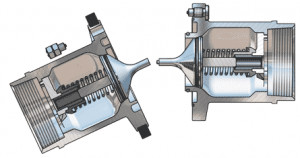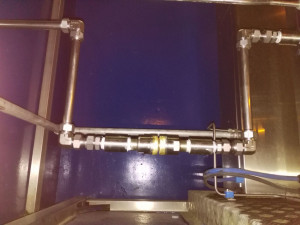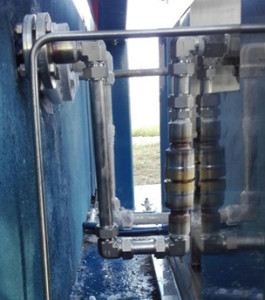Breaking fitting of type break away
- Material: Stainless steel and Polytetrafluoroethylene (PTFE)
- Operating principle: in normal operation, the contact between the end of the two check valves allows the circulation of the fluid. When tearing the fitting, the spacing of the two parts causes the positioning of the valves and the total closure on each side of the fitting.
A leak occurred in a liquefied natural gas (LNG-C) refuelling station when the reciprocating pump used to supply the “CNG” system was started. This automatic start-up occurred when the level of gas stored in the “CNG” cylinders reached a trigger level after several vehicles had been filled over the course of the evening. The leak was detected by a sensor that renders the station safe by shutting down and securing the pump. When the pocket of gas had evaporated, the sensor no longer detected gas, thereby allowing the pump to resume operation. Gas began leaking once again. In the meantime, an employee at a neighbouring company heard the noise made by the failed coupling and noticed a cloud forming (caused by the condensation of the humidity in the air when the LNG had vaporised). The fire brigade and the site’s on-call staff were notified. The fire brigade established an exclusion zone with a safety perimeter and blocked off access to the site. The station’s facilities management supervisor was also contacted. With the firefighters, he monitored the final operations to secure the station: closure of all the automatic valves. A half an hour later, the maintenance personnel reinforced the safety procedures by closing the manually operated valves.
The leak was attributed to the rupture of the break-away coupling on the high-pressure LNG-C pump. The failure appears to have been caused by mechanical stress from repeated thermal stresses imposed on the connection through which a cryogenic fluid passes (contraction/expansion). The coupling’s supplier also stated that the initial assembly must not have been performed correctly.
The operator plans to implement the following measures:
- installation of anti-vibration components;
- reinforced verification of the hermetic seal and the tightness of equipment connections during monthly preventive maintenance operations;
- creation of an alarm reporting system via SMS messages sent to various telephone numbers for quicker intervention;
- increased awareness among site users, on-call staff and the Fire and Emergency Services about what to do in the event of an accident;
- modification of the PLC alert chain to ensure that the installation is completely secured when gas is detected, without the possibility of automatic restart (human intervention is mandatory on site in order to restart the installation).







